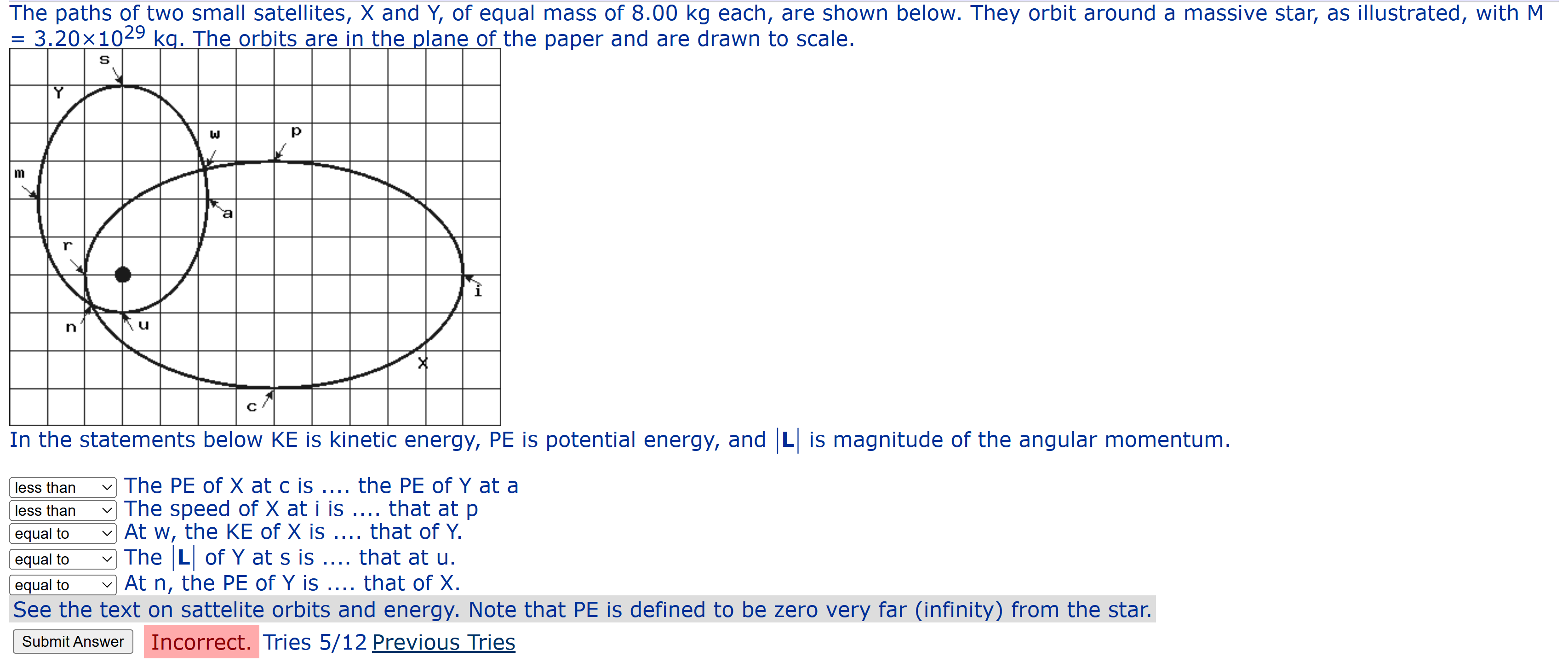The PE of X at c is .... the PE of Y at a. The speed of X at i is .... that at p. At w, the KE of X is .... that of Y. The |L| of Y at s is .... that at u. At n, the PE of Y is ...... The PE of X at c is .... the PE of Y at a. The speed of X at i is .... that at p. At w, the KE of X is .... that of Y. The |L| of Y at s is .... that at u. At n, the PE of Y is .... that of X.

Understand the Problem
The question describes the orbital mechanics of two satellites around a massive star and asks for comparisons of their potential energy, speed, kinetic energy, and angular momentum at various points in their orbits.
Answer
- PE_X(c) < PE_Y(a) - v_X(i) < v_Y(p) - KE_X(w) < KE_Y(a) - |L_Y(s)| > |L_X(u)| - PE_Y(n) > PE_X(X)
Answer for screen readers
- The PE of X at c is less than the PE of Y at a.
- The speed of X at i is less than that at p.
- At w, the KE of X is less than that of Y.
- The magnitude of |L| of Y at s is greater than that at u.
- At n, the PE of Y is greater than that of X.
Steps to Solve
- Understanding Potential Energy (PE)
The potential energy (PE) between two masses due to gravity is given by the formula:
$$ PE = - \frac{GMm}{r} $$
Where:
- ( G ) = gravitational constant ( (6.674 \times 10^{-11} , m^3 , kg^{-1} , s^{-2}) )
- ( M ) = mass of the star ( (3.20 \times 10^{29} , kg) )
- ( m ) = mass of the satellite ( (8.00 , kg) )
- ( r ) = distance from the center of the star to the satellite
This implies that as ( r ) decreases (i.e., as the satellite gets closer to the star), ( PE ) becomes more negative.
- Comparing PE at Points c and a
For satellite X at point c, the distance ( r ) is shorter compared to satellite Y at point a. Thus:
$$ PE_X(c) < PE_Y(a) $$
This means the PE of X at c is less than that of Y at a.
- Understanding Kinetic Energy (KE)
The kinetic energy (KE) of an object in orbit can be described by the formula:
$$ KE = \frac{1}{2} mv^2 $$
Where ( v ) is the orbital speed. In a stable orbit, total mechanical energy is the sum of KE and PE.
- Comparing Speed at Points i and p
At point i, satellite X is further from the star compared to satellite Y at point p. Therefore, satellite Y, which is closer, must move faster to maintain its orbit. Hence:
$$ v_X(i) < v_Y(p) $$
This means the speed of X at i is less than that of Y at p.
- Comparing KE at Points w and a
Since Y is closer at point a, it has a higher speed than satellite X at w. Consequently, the kinetic energy will also be higher for Y:
$$ KE_X(w) < KE_Y(a) $$
Thus, the KE of X at w is less than that of Y at a.
- Comparing Angular Momentum at Points s and u
The magnitude of angular momentum ( L ) is given as:
$$ L = mvr $$
Since satellite Y at s has a greater distance (radius) and is moving with a higher speed than satellite X at u, we determine:
$$ |L_Y(s)| > |L_X(u)| $$
This means the angular momentum of Y at s is greater than that at u.
- Comparing PE at Points n and X
At point n, satellite Y is further from the star than satellite X. By the same reasoning with the potential energy formula, we find:
$$ PE_Y(n) > PE_X(X) $$
Hence, the PE of Y at n is greater than that of X.
- The PE of X at c is less than the PE of Y at a.
- The speed of X at i is less than that at p.
- At w, the KE of X is less than that of Y.
- The magnitude of |L| of Y at s is greater than that at u.
- At n, the PE of Y is greater than that of X.
More Information
In orbital mechanics, potential energy decreases as an object approaches the center of mass it orbits. Conversely, kinetic energy increases as an object gets closer due to the conservation of angular momentum in a gravitational field. Understanding these relationships is essential for analyzing orbital dynamics.
Tips
- Confusing potential energy with kinetic energy: Remember that PE is more negative when closer to the massive body, while KE increases with speed, which is generally higher in closer orbits.
- Not recognizing that angular momentum depends on both mass, speed, and radius; therefore, more distant and faster satellites will have greater angular momentum.
AI-generated content may contain errors. Please verify critical information